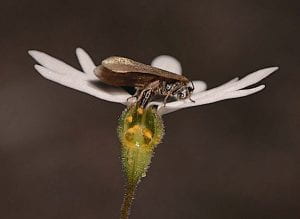To what extent is the signal of coevolution embedded in subtle shifts in trait correlations rather than in the evolution of novel traits that each have large effects on fitness and evolution?
In recent years, we have become increasingly interested in how complex traits and trait correlations are shaped by coevolution.
• How do complex traits and trait correlations of coevolving interactions differ among ecosystems across thousands of kilometers, and how does that affect the ecological outcomes of these interactions?
• How does coevolution shape traits and trait correlations when multiple species are involved in an interaction rather than just a single pair of species?
Some of these studies use the sizes and shapes of woodland star (Lithophragma) flowers and the shapes and sizes of their coevolving Greya moth pollinators, which pollinate of flowers and also lay eggs in those flowers. The plants attract the moths, and sometimes other pollinators, using chemically complex bouquets of floral scents. Once a moth is on a flower, the exact size and shape of the flower and moth affects how many of the hundreds of floral ovules are fertilized and how easily the moth can reach the floral ovary to lay its eggs.
Some of these studies have involved analyses of how phylogenetic lineages, species, and populations of saxifragaceous plants have diversified in traits and trait correlations across western North America in a wide range of ecosystems. For other studies, we have surgically cut windows into the side of flowers and used time-lapse macrophotography to evaluate precisely which moth body parts carrying pollen touch which plant reproductive parts (i.e., anthers; stigmas). Examples of papers from this work include Thompson et al. (2013) Proceedings of the National Academy of Sciences USA, Thompson et al. 2017 American Naturalist, Friberg et al. (2013) Annals of Botany, and Friberg et al. 2019 PNAS.
Collectively, these ongoing studies have shown that, at least in the interactions between these plants and Greya moths, much of the signal of coevolution is in subtle shifts of trait correlations among the traits important for fitness in the plants and the moths rather than in the evolution of truly novel traits.
For yet other studies, we have taken morphologically and chemically divergent populations of woodland star (Lithophragma) plants and hybridized them to evaluate the evolutionary quantitative genetics of traits important for their interactions with coevolving Greya moths. These experiments have been led by Mia Tayler Water and, as of 2020, are nearing completion. Analyses of these results will help us to understand the underlying genetics of the morphological and trait correlations. These F2 hybrid crosses have also provided novel trait combinations that we can use for subsequent experiments on selection and experimental evolution.
These studies bring together many difficult problems in evolutionary biology and evolutionary ecology: how do complex traits evolve; what drives the evolutionary rates of populations; what allows species and interactions with other species to persist sometimes for millions of years amid ongoing environmental change; and how do evolutionary and coevolutionary processes shape the web of life.

A Greya politella (Prodoxidae) moth about to pollinate and lay its eggs in a flower of Lithophragma parviflorum (Saxifragaceae)